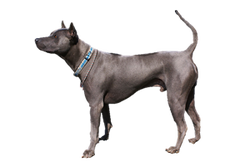Thai Ridgeback
Mah Thai Lang Aan

The Thai Ridgeback is one of several breeds that have a ridge of fur on its back. This ridge can be in several shapes including the Needle, Hands-in-Prayer, Lute, Violin, Horse-saddle, Arrow, and Bowling-pin patterns.
Originally kept as a hunting dog, their prey includes birds, boar, deer and tapirs. These dogs are not trained to hunt, the young pups simply learn from the old ones. As a secondary role they also work as property guards and protectors. It is said that a Thai Ridgeback can kill a cobra in defence of itself or its owner.
Originally kept as a hunting dog, their prey includes birds, boar, deer and tapirs. These dogs are not trained to hunt, the young pups simply learn from the old ones. As a secondary role they also work as property guards and protectors. It is said that a Thai Ridgeback can kill a cobra in defence of itself or its owner.
Thai Ridgeback Standards
- 23-26"
- 51-7 lbs
- medium-sized primitive breed
- erect, triangular ears
- tail reaches hock, carried erect
- coat is soft, fine and smooth
- has ridge that grows in opposite direction on back
- black
- blue
- fawn
- red (may have black mask)
History of the Thai Ridgeback
The Thai Ridgeback is considered an ancient breed, with similar dogs showing in cave paintings in Cambodia and Thailand that are at least 3,000 years old. Despite this, limited information can be found on the breed. They remained virtually unknown to the outside world until 1975. Today they are recognized as the National Dog of Thailand and given the official title of Royal Dog.
It is important to note that the only recognized breeds that have a ridged coat are the Thai Ridgeback and the Rhodesian Ridgeback of Africa. There are three other breeds that remain unrecognized with the same traits; the Africanis of South Africa, Phu Quoc Ridgeback of Vietnam, and the Combai of India. It has been greatly disputed as to whether or not these breeds are related (and which came first if they are) or if this genetic mutation has simply occurred in various geographic locations.
Related Breeds:
